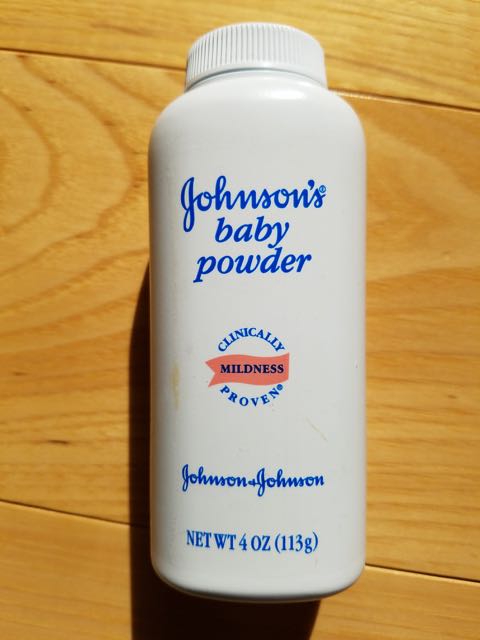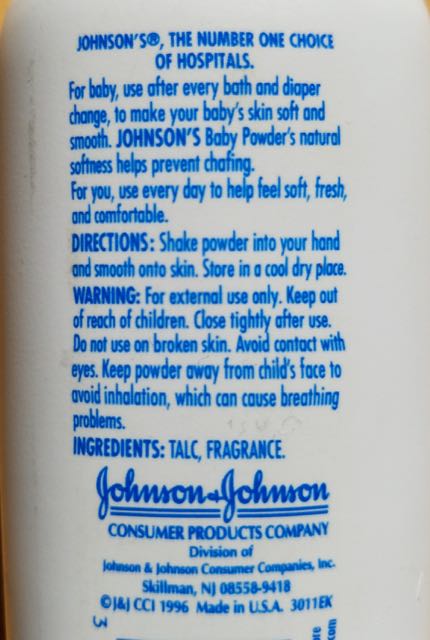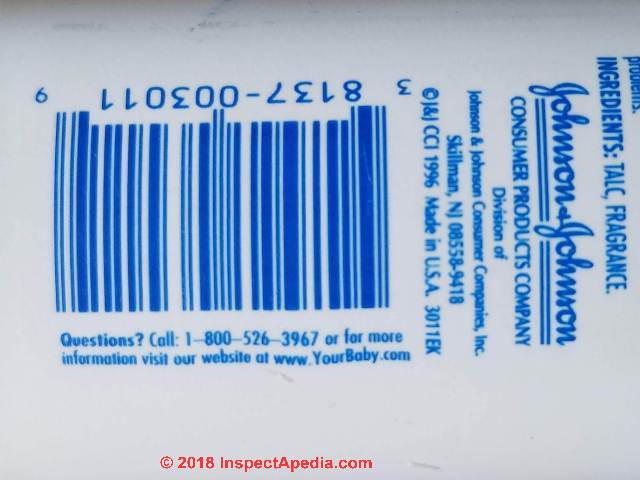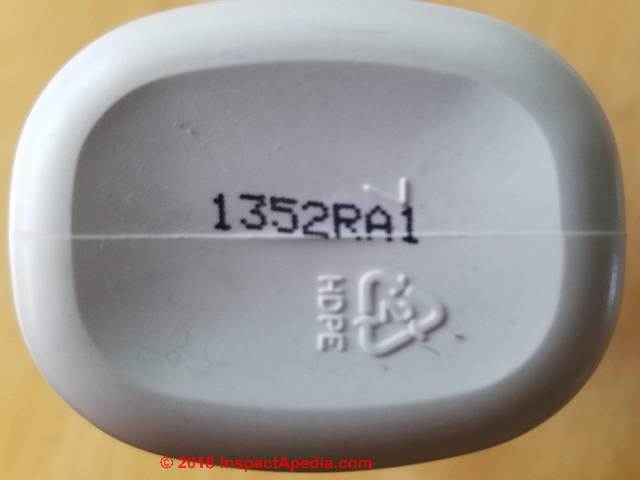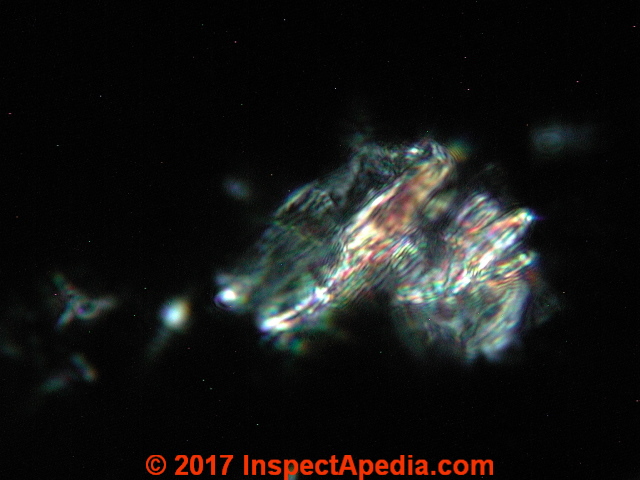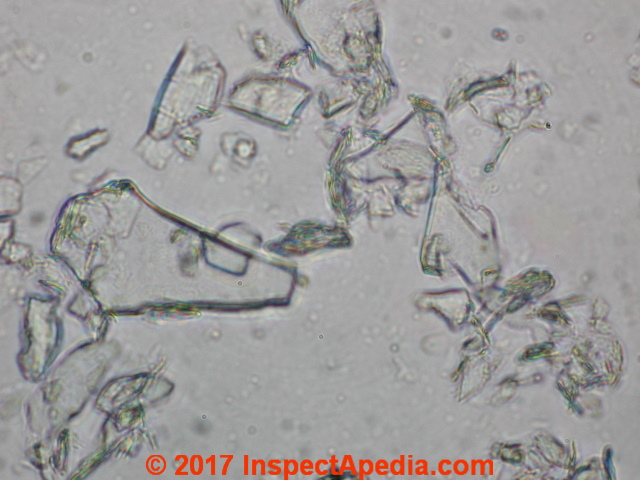 Talc Particles & Asbestos Content
Talc Particles & Asbestos Content
Photos & properties of talc in baby powder; accuracy of asbestos detection in talc
- POST a QUESTION or COMMENT about the properties of talc in baby powder
Talc & talcum powder properties, asbestos hazards, questions about accuracy of asbestos detection in talc, status of the Johnson & Johnson asbestos-talc baby powder litigation.
We include a description of talc used in baby powder & body powder and photographs of talc particles in transmitted & polarized light under the microscope.
Page top photograph: talc particles at 100x in polarized light, photographed by the author [DF] at McCrone Research in Chicago. The author has worked as a forensic microscopist, aerobiologist, and environmental investigator.
InspectAPedia tolerates no conflicts of interest. We have no relationship with advertisers, products, or services discussed at this website.
- Daniel Friedman, Publisher/Editor/Author - See WHO ARE WE?
Physical Properties of Talc, its Asbestos Content, Cancer Risk
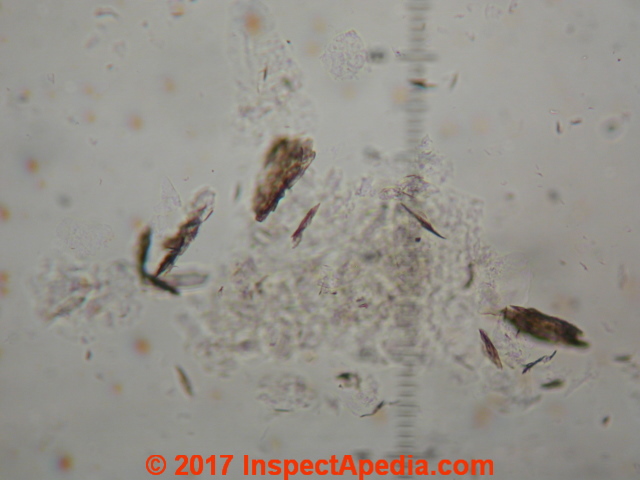 One of the earliest providers of talcum powder as a consumer product was Johnson & Johnson's® Baby Powder first marketed in 1894 by that company who was already a producer of medical products. Johnson's® Baby Powder became the progenitor of that famous company's baby products business.
One of the earliest providers of talcum powder as a consumer product was Johnson & Johnson's® Baby Powder first marketed in 1894 by that company who was already a producer of medical products. Johnson's® Baby Powder became the progenitor of that famous company's baby products business.
Why was talc used in some powder products in the first place? Physically to the touch talc feels soft and oily; the mineral is very soft, having a Mohs scale grade of 1.
Talc or talcum is essentially a clay mineral made of hydrated magnesium silicate.
The chemical formula for talc is H2Mg3(SiO3)4 or Mg3Si4O10(OH)2. Some talc deposits also contain asbestos, so some talc products might also contain that material, depending on where the talc was mined.
Asbestos-containing talc is known to be a respiratory hazard although even pure asbestos-free talc may be hazardous as well. Some of that research is cited in this article.
Watch out: because talc was used in or on a wide variety of products and in some cases is still used in some products including cosmetics (Gordon 2014), asbestos-containing talc might be on or contained in some of those items.
However not all products containing talc contain detectable asbestos, and some other products using talc (rubber band dust) involved so little talc that in our opinion it's not likely that there is a measurable asbestos hazard from their use or presence.
Article Contents
- BOTTOM LINE: ASBESTOS MAY BE PRESENT in SOME TALC PRODUCTS ... OR NOT
- DOES CURRENT BABY POWDER CONTAIN TALC?
- DOES TALC ALWAYS CONTAIN ASBESTOS?
- TALC-ASBESTOS LITIGATION / SETTLEMENT STATUS
- OTHER SMALL PARTICLE HAZARDS in TALC
Bottom Line on Asbestos in Talc
Bottom line: the fact that a product contains talc can not by itself be taken as proof that that product contains asbestos. In forensic investigation we say absence of evidence is not evidence of absence.
That means that the reliability of a study that did not detect asbestos in a talc sample depends on the expertise of the analysts and the lab procedures used.
A US FDA study (cited below) did not detect asbestos in the company's baby powder. Not all baby powder nor related products contain talc but some do. Some but not all talc may contain asbestos.
The J&J company has sold multiple powder types and brands including two types of baby powder products for which the company listed these ingredients:
- Corn-starch based baby powder: Zea Mays (Corn) Starch, Tricalcium Phosphate, Fragrance (Aloe Barbadensis Leaf, Tocopheryl (Vitamin E)).
- Traditional talc-based baby and body powder: Talc, fragrances. (Sales halted July 2020 - Ed.)
Some of the company's comments about talc and about asbestos in their products are included in this article.
Watch out: In this article we explain that various asbestos in talc studies had varying results and that lab technique is critical when screening talc for asbestos.
Putting aside possible conflicts of interest, our own forensic lab training and experience lead us to emphasize that when screening materials for very small particles such as asbrestos in talc, everything depends on the expertise of the forensic microscopist and the methodology used.
In other studies that I (DF) have conducted on fiberglass particles in dust I found that unless the forensic lab used a mountant of exactly the right refarctive index and used exactly the requisite microscopy procedure those very small particles, down in the 1u range, are simply not observed, even if they are present in abundance.
Some currently-sold body powders such as Gold Bond® Ultimate Comfort Body Powder & Johnson & Johnson's® Baby Powders do not contain talc but other body and baby-powder products do use talk.
Watch out: OPINION: because some of them contain extremely-small particles in the 1u range or even smaller, body powders containing even asbestos-free talc might be a respiratory irritant or hazard. Be sure that you use such products with care, following the manufacturer's instructions.
...
Does Current Baby Powder or Body Powder Contain Talc?
Maybe. Talc is or was used in some but not all baby and body powders.
Historically talc was the main and sometimes the only ingredient in body powders used by adults as well as in baby powder.
Most older body and baby powders produced by many companies world wide were typically based on talc as the primary ingredient, often with the addition of a fragrance.
[Click to enlarge any image]
The Johnson & Johnson's baby powder shown above as well as at least one of the company's current baby powders indicate talc as the product's principal ingredient.
The company, in the references we give here, maintains that the talc in its products is safe.
That company also offers Johnson's Lavender Powder, a cornstarch-based baby powder that also contains lavender and chamomile.
The company's web page describing this product, one of five it describes as "baby powder" does not contain the word "baby" on the product front label but the product description refers to baby" as
"... Soothe your baby’s senses after bath time or while diapering with lavender powder. Our cornstarch baby powder with lavender & chamomile is designed to soothe and gently absorb excess moisture on baby’s skin, leaving it dry, fresh and smooth. " - J&J Lavender powder information retrieved 2018/07/15, original source: https://www.johnsonsbaby.com/baby-products/johnsons-lavender-baby-powder?upcean=381370030171
Talc's properties that made it an excellent lubricant also made it a successful body powder as we seen this product from Johnson & Johnson from 1996.
According to the American Cancer Society talc was removed from commercial talc products in the 1970's. Just what is the scope of "commercial products" is unclear.
J&J Baby Powder Talc Content in Recent Product?
In the U.S., in 2018 and continuing into 2020, a flurry of concern about the risk of asbestos in Johnson & Johnson's baby powder raised a new cloud of dusty powder worth reporting and understanding here.
- Girion, Leslie, "Special Report: J&J Knew for Decades That Asbestos Lurked in Its Baby Powder [website] Reuters cited in in The New York Times, 14 December 2018, original source: www.nytimes.com/reuters/2018/12/14/us/14reuters-johnson-johnson-cancer-special-report.html located 2019/11/01 at https://www.reuters.com/investigates/special-report/johnsonandjohnson-cancer/
Excerpts: A Reuters examination of many of those documents, as well as deposition and trial testimony, shows that from at least 1971 to the early 2000s, the company’s raw talc and finished powders sometimes tested positive for small amounts of asbestos, and that company executives, mine managers, scientists, doctors and lawyers fretted over the problem and how to address it while failing to disclose it to regulators or the public.
...
It didn’t tell the agency that at least three tests by three different labs from 1972 to 1975 had found asbestos in its talc – in one case at levels reported as “rather high.”
...
The World Health Organization and other authorities recognize no safe level of exposure to asbestos. While most people exposed never develop cancer, for some, even small amounts of asbestos are enough to trigger the disease years later.
Just how small hasn’t been established. Many plaintiffs allege that the amounts they inhaled when they dusted themselves with tainted talcum powder were enough. - Hsu, Tiffany & Roni Caryn Rabin, "Baby Powder is Recalled for Asbestos", The New York Times, 19 Oct. 2019, p. B1,3.
Excerpt: Johnson & Johnson, which has spent years insisting that its baby powder is safe, recalled 33,000 bottles of the p;roduct on Friday after the Food and Drug Administration discovered evidence of asbestos, a known carcinogen in one of the bottles.
... The decision to pull the baby powder, sourced from China an ddistributed last year ...
... The recall was prompted by F.D.A.'s discovery of trace [emphasis ours] levels of chrysotile asbestos in samples from a bottle of baby powder bought from an online retailer. ... lot number 22318RB ... out of an abundance of caution ...
... Dr. Susan Nicholson, Johnson & Johnson's vice president of women's healty said ... that the FDA's report showed "an extremely unusual finding" that was "inconsistent with our testing to date."
... Several earlier F.D.A. tests, including one in the past year, and another about a decade ago, did not detect any asbestsos in samples of baby powder.
... This year, after consumer tests found asbestos in makeup kits for children sold at Claire's, the F.D.A. followed up with its own tests.
It detected the carcinogen in half of 20 products, including Claire's eye showadow and ocmpact powder, JoJo Siwa makeup sold at Claires, and bronzers, blush, and other makeup made by Beauty Plus Global City Color Cosmetics and sold in retail outlets.
The products were eventually recalled. ... The products are a tiny percentage of the thousands of personal-care products available ...
- Reuters, "Recalled Baby Powder Will be Pulled, CVS Says", The New York Times, 25 October 2019 p. B2
Excerpts: ... CVS said ... it would pull all 22-ounce bottles of Johnson & Johnson baby powder from its stores and onlien to comply with Johnson & Johnson's recall because of possible asbestos contamination ... limited to one lot of baby powder produced and shipped in the United States in 2018 - Hsu, Tiffany, "J&J Says Tests Don't Find Asbestos in Baby Powder", The New York Times, 30 October 2019, p. B2
Excerpts: Johnson & Johnson said ... it did not find asbestos in multiple tests of a bottle of baby powder that the [F.D.A.] said contained trace amounts of the carcinogen. - January 2020: "New Mexico Joins Wave of Talc-Related Lawsuits", The New York Times, The Digest, Health, p. b2, 2020/01/04. f
This brief article cites the attorney general of New Mexico's accusation that J&J misled consumers, especially children and black and hispanic women, about the safety of its talc products, asserting that the company concealed and failed to warn about dangers "... thought to include lung disease, ovarian cancer, and mesothelioma...".
J&J responded that the company's talc product safety is supported by decades of scientific evidence.
Additional tests did not find asbestos in J&J baby powder samples
By the end of October 2019 J&J reported that both its own tests of "a bottle of baby powder" that the FDA said contained trace amounts of asbestos ["the carcinogen"] found that in fact there was no asbestos in that sample.
Johnson & Johnson's test result finding the very container of its baby powder previously asserted to contain asbestos was asbestos-free was confirmed by another forty-eight tests of samples from the recalled lot of baby powder in tests conducted by two independent laboratories.
These tests occurred after the company had recalled 33,000 bottles of baby powder that had been said to contain "trace levels" of chrysotile asbestos after one such bottle, purchased from a retail outlet, was found to contain the contaminant.
Hsu's NY Times report on 30 October 2019 explained how this happened.
Three samples did initially test positive for asbestos, but after an investigation by the lab the contaminatnio was found to be coming from a portable air conditioner in the room. - (Hsu 2019/10/30)
Opinion - trace levels of asbestos in test samples could come from an outside source
Really? Sure. Separately we have documented the use of asbestos in some air conditioning equipment including the A/C unit itself as well as ductwork. In fact, asbestos was used in air conditioing systems including air conditioner air handlers, ductwork, filters, duct vibration damperners, and as constituents in some wall and window A/C units.
In our OPINION, particularly when the level of asbestos fiber or particle detection is very sensitive it is entirely possible that contaminants from a nearby source could enter an asbestos sample being processed in a forensic lab.
Example: when a lab technician is working carefully and under the protection of a draft hood intended to keep any sample particles from escaping into the laboratory space, the very draft created by the exhaust draft fan might draw a few contaminating particles from a nearby source such as an air conditioner whose components included asbestos in a friable form such as a gasket or insulation.
For details see
ASBESTOS in AIR CONDITIONERS
ASBESTOS DUCT DAMPENERS
ASBESTOS DUCTS, HVAC
...
Does Talc Necessarily Contain Asbestos?
Whether or not talc contains asbestos depends principally on the mine from which talc was obtained. Some talc deposits also include naturally-occurring asbestos.
Maybe: or Sometimes, as a common impurity. Often not.
The U.S. FDA's own independent study of the occurrence of asbestos in talc did not detect asbestos in Johnson & Johnson's Baby Powder. (US FDA information retrieved 2018/07/15 and cited below.)
Here is a screen shot of Johnson & Johnson's information about talc. [Click to enlarge any image]
At a "facts about talc" link in the company's Talc citation, the company explains:
The testing methodology used to detect asbestos in cosmetic grade talcum powder was developed by the Personal Care Products, formerly known as the Cosmetic, Toiletry and Fragrance Association (CTFA), Inc., in 1976 and is still used and accepted by the U.S. Food and Drug Administration.
The methodology we use for testing Johnson’s Baby Powder exceeds the CFTA industry standard. - source: The Facts on Talcum Powder Safety, web page, retrieved 2018/07/15, original source: http://www.factsabouttalc.com/
Watch out: Even if the talc powder contained no asbestos, the talc itself might be a respiratory health hazard, in part because of its very small particle size. Particles down in the micron range are inhaled very deeply into the lung and are difficult to expel.
There could be another talc hazard: according to a some scholarly studies by experts cited below, talcum powder might cause cancer in the ovaries, particularly if the powder applied to the genital area moves through the vagina, uterus, and fallopian tubes to the ovary.
Photos above and just below show an older container of Johnson's Baby Powder containing Talc. This older J&J Talc-containing baby powder was purchased in New York before 2015 and contains talc along with the product and production codes shown below.
We have no translation of that into a product date but we note that the product label refers the user to the company's website and also provides a consumer information telephone number.
[Click to enlarge any image]
In our photos of the information label for Johnson & Johnson's Baby Powder, (C) 1996, the text reads:
Johnson's® The Number One Choice of Hospitals
For baby, use after ever bath and diaper change, to make your baby's skin soft and smooth. JOHNSON's Baby Powder's natural softness helps prevent chafing. For you, use every day to feel soft, fresh, and comfortable.
DIRECTIONS: Shake powder into your hand and smooth onto skin. Store in a cool dry place.
WARNING: For external use only. Keep out of reach of children. Close tightly after use. Do not use on broken skin. Avoid contact with eyes. Keep powder away from child's face to avoid inhalation, which can cause breathing problems.
INGREDIENTS: TALC, FRAGRANCE
...
Recent Litigation Argues that Talc-containing Baby & Body Powders May be Carcinogenic
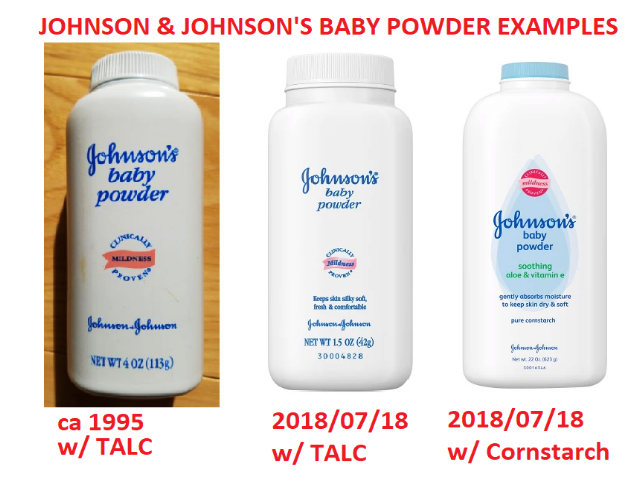 July 2024: Johnson & Johnson Co. Proposes New Talcum Powder Settlement
July 2024: Johnson & Johnson Co. Proposes New Talcum Powder Settlement
In a third effort to close out lawsuits from people who claim having suffered ovarian cancer the company proposed a new settlement term.
Moreno, J. Edward, "Johnson & Johnson Is Proposing New Talcum Powder Settlement [Times article] The New York Times, 2 Ma7 2024 p. B4
Excerpt:
Johnson & Johnson said on Wednesday that it would ask tens of thousands of people suing the company over claims that its talcum powder products caused their cancer to approve a new $6.5 billion settlement, its third attempt to resolve the lawsuits.
The proposal would settle nearly all current and future claims that its talcum powder products caused ovarian cancer, the company said. Like the previous two efforts — this 2021 The New York Times Article
and this 2024 article from the same publisher
J&J: the new deal will try to use an element of the bankruptcy system to settle the claims. —
Judges have rejected the two previous attempts ...
January 2023: Court rejects J&J Bankruptcy Filing re Talc/Asbestos Litigation
On Monday, 30 January 2023 a federal appeals court rejected a bankruptcy filing by LTL Management, an Johnson & Johnson subsidiary created in 2021 to absorb liability for litigation associated with lawsuits concerning claims of injury from talc-contaminated talcum powder sold by the company.
Facing billions of dollars in payouts, the company formed the subsidiary in an effort to shield the rest of its operations. Days after LTL was formed it filed for bankruptcy protection. This process, popularly known as the "Texas Two Step" is designed to allow companies to escape significant liability.
That Chapter 11 bankruptcy filing was dismissed by the U.S. Court of Appeals for the 3rd Circuit (Philadelphia). The court said that the parent company, Johnson & Johnson, was not facing the kind of distress that Chapter 11 bankruptcy filing is intended to address.
Plaintiffs claim that the company knew that its talcum powder products contained "traces of asbestos" for decades. Asbestos is a cancer-causing substance. Some plaintiffs claim that their use of J&J's products led to ovarian cancer, mesothelioma, or that even if the talc didn't contain asbestos it was an irritant that caused cancer.
The company maintains that its products do not contain asbestos and do not cause cancer. The company's current powder products use cornstarch rather than talc that was found in older products. - Isabella Simonetti, "Court Rejects Bankruptcy to Contain Talc Liability"., The New York Times, 2023/01/31
July 2020: J&J Stops Selling Talc Baby Powder Only in U.S. and Canada
After decades of fighting off regulators and lawsuits regarding the asbestos content of Johnson & Johnson Baby Powder, the Company finally announced in May that it would “wind down” North American sales of the product.
The company has lost some major court battles in defending the product and is still facing more than 19,000 lawsuits in the U.S.
The company is not taking action to stop the sale of this product in other countries.
In the European Union, cosmetic products with talc have to include the warning ‘keep powder away from children's nose and mouth.’
...
- Source: Occupational Knowledge International Newsletter, July 2020, Occupational Knowledge International, 4444 Geary Boulevard, Suite 208, San Francisco CA 94118 USA, Tel: (415) 221-8900 Website: www.okinternational.org
July 2018: Court Awards $4.14 Billion to Plaintiffs Suing J&J
In July 2018 a Missouri circuit court jury trial awarded $4.14 billion in punitive damages and $550. million in compensatory damages to 22 women and their families who had sued Johnson & Johnson Corporation for failing to warn them about the risk of cancer associated with the company's baby and body powder.
Mark Lanier, an attorney representing the plaintiffs said that Johnson & Johnson had spent years hiding evidence of abestos in some of its talc-based products and that such products should have a warning on the product label.
The Johnson & Johnson company expressed deep disappointment and said it planned to appeal the decision, calling it the verdict an effect of a fundamentally unfair process and expressing confidence that their products do not contain asbestos and do not cause ovarian cancer.
The company did not question the health risks associated with asbestos, but rather said that research on talc's carcinogenicity is inconclusive. - Jsu, Tiffany, "Jury Awards $4.7 Billion IN Talcum Powder Case", The New York Times, 13 July 2018, p. B6.
Really? While the conclusion that talc-containing baby and body powders has been questioned including in recent court cases, some but not all of the studies we cite below (Merritt 2008) provide important findings that suggest at the least, prudent avoidance of the use of asbestos-containing talc.
Illustrations above and below show examples of three J&J baby powder products and their label markings.
In August 2017 in the U.S. a Los Angeles jury awarded $417 million to Eva Echeverria who blamed her terminal cancer illness on Johnson's Baby Powder that she had used for decades, since the age of eleven.
The case argued that J&J failed to warn consumers of the cancer risk of using its asbestos-containing baby powder. [The company's current (2017) baby powder does not contain talc - Ed.].
In October4 2017, on appeal Los Angeles Superior Court Judge Maren Nelson, stating that the evidence was insufficient and that the award was excessive [in an example of of self-contradicting viewpoints? - Ed.] vacated the jury's award and granted Johnson & Johnson's request for a new trial.
Also an appeals court in Missouri vacated a $72 million award in a similar case involving Jacqueline Fox of Birmingham AL. Both women died of ovarian cancer.
Johnson & Johnson, according to the Times stated that while ovarian cancer is a devastating disease it is not cased by the cosmetic-grade talc used in Johnson & Johnson's Baby Powder for decades.
The Times also reported that "the American Cancer Society
said that more studies should be done in order to determine whether today's products are safe", and that "the National Cancer Institute said that 'the weight of evidence does not support an association between perineal talc exposure and an increased risk of ovarian cancer.'"
...
Size of Talc Particles vs Possible Small Non-asbestos Particle Hazards
 Our photograph illustrates natural talc particles magnified at 100x, photographed by the author at McCrone Research in Chicago.
Our photograph illustrates natural talc particles magnified at 100x, photographed by the author at McCrone Research in Chicago.
What is the actual size of typical talc particles in baby powder sold in the 1990s? Talc is considered a PM10 particle.
However talc contains smaller particles down to about 1u and larger particles up to about 55u.
About 80% of the particles in a talc sample will be comprised of particles from 1-20 microns, with larger particles up to about 55u making up the remaining 20%. (Cen 2007, Fig. 5).
The photograph above was made in transmitted light at 1200x using a POLAM microscope. This lab photograph shows talc particles from Johnson & Johnson's baby powder from a container whose label text was marked ©1996.
In the photo above we have magnified those Johnson's® baby powder talc particles to about 1200x, or 1200 times the actual particle size.
As we illustrate with the two red lines, the largest particle in the photo measures approximately 15u in in its longest direction and 10u in its widest cross-section.
Take a closer look at the other particles in that photo.
Clearly some of the talc fragments are much smaller, down in the 1u range. There may be still-smaller particles that are below the limits of detection in light microscopy. Use of SEM or TEM may be required to detect such ultra-small particles.
While some research on small fiberglass particles argues that these very small particles are absorbed or "dissolved" by the body and may not be a health risk, other researchers such as Baan (2007) reached the opposite conclusion.
 Below is an additional photograph of talc particles from this very sample in polarized light.
Below is an additional photograph of talc particles from this very sample in polarized light.
Watch out: very small particles, PM 2.5 and smaller, particularly at 1u and smaller, may be undetected in bulk, air, or dust samples and so may go unreported.
In my OPINION this risks a failure to detect what might be important environmental exposures for some conditions. Baan (2007) notes that there can be health hazards from inhaling very small particles of talc (or its contaminants) even for talc that is asbestos-free.
The Working Group evaluated inhaled talc not containing asbestos or asbestiform fibers as not classifiable as to its carcinogenicity to humans, Group 3.
The Working Group noted that prolonged exposure to inhaled particles at sufficiently high concentrations in experimental animals may lead to impairment of normal clearance mechanisms in the alveolar region of the lung, resulting in a continued buildup of particles that eventually leads to excessive lung burdens accompanied by chronic alveolar inflammation.
The inflammatory response may give rise to increased generation of reactive oxygen species, cell injury, cell proliferation, fibrosis, induction of mutations, and, ultimately, cancer.
Since many of these steps also occur in workers in dusty jobs, such as coal miners, data on cancer in animals obtained under conditions of impaired lung clearance were considered relevant to humans.
In addition, impaired lung clearance in rodents exposed to ultrafine particles occurs at much lower mass concentrations than with fine particles, which adds to the human relevance. (Baan 2003)
...
Asbestos content in talc, Possible Health Hazards of talcum powder, baby powder
I did not detect asbestos in the Johnson's Baby Powder sample that was examined in our lab. I did see the range of particle sizes we discussed above.
Below is another polarized light photo of more talc-based baby powder showing by light variations the structural planes in this material.
[Click to enlarge any image]
Watch out: Asbestos occurs naturally in some talc deposits. Talcum powder or talc that contains asbestos is generally accepted as a respiratory hazard and as capable of causing cancer if inhaled.
Where talc is used in current consumer products like baby powder or body powder or cosmetics, one might seek assurance that those products do not contain asbestos
. In fact in the U.S. an FDA test of a number of such products did not detect asbestos in them. Citations are given later in this article and also inReferences or Citations .
...
Examples of Products Using Talc or Talcum Powder
This list has been moved to TALCUM POWDER PRODUCTS
...
Research on Talc & Asbestos in Talc & the Role of Perineal Use of Talc in Ovarian Cancer
...
Reader Comments, Questions & Answers About The Article Above
Below you will find questions and answers previously posted on this page at its page bottom reader comment box.
Reader Q&A - also see RECOMMENDED ARTICLES & FAQs
Reader Question: Concern for asbestos in talc on an inner-tube made in Bangladesh
I brought a agnite inner tube on amozen .it say made Bangladesh is white powder on inner tube asbestos containing powder brought may 2020 how do I no ? - S.S. by private email 2020/05/03
Moderator reply:
You would need to collect a sample of the dust and have it analyzed by an asbestos test lab.
Search this site forTEST KIT for DUST, MOLD, PARTICLES: INSTRUCTIONS
Reader follow-up:
Do talc contain asbestos in 2020? - Anon 2020/05/04
Moderator reply:
Some talcs currently for sale might contain asbestos, depending on where the talc was mined.
See ASBESTOS in TALCUM POWDER
...
Continue reading at RESEARCH: RELATION of TALC & ASBESTOS to OVARIAN CANCER or select a topic from the closely-related articles below, or see the complete ARTICLE INDEX.
Or see ASBESTOS in TALCUM POWDER FAQs - questions and answers posted originally at this page.
Or see these
Recommended Articles
- ASBESTOS IDENTIFICATION IN BUILDINGS
- ASBESTOS LIST of PRODUCTS
- ASBESTOS UNDER the MICROSCOPE
- ASBESTOS PRODUCING COMPANIES & TRUSTS for a most-complete list of companies that produced products containing asbestos
- ASBESTOS PRODUCTS BANNED vs PERMITTED U.S. 2023
- EPA Sample List of Asbestos Containing Materials [PDF] at InspectApedia.com
- FIBERGLASS FRAGMENT HAZARDS in AIR or DUST
- FORENSIC INVESTIGATION of BUILDINGS
- FORENSIC & IAQ LAB MICROSCOPE TECHNIQUES
- RESEARCH: RELATION of TALC & ASBESTOS to OVARIAN CANCER
- TALCUM POWDER PRODUCTS
Suggested citation for this web page
ASBESTOS in TALCUM POWDER at InspectApedia.com - online encyclopedia of building & environmental inspection, testing, diagnosis, repair, & problem prevention advice.
Or see this
INDEX to RELATED ARTICLES: ARTICLE INDEX to ASBESTOS HAZARDS
Or use the SEARCH BOX found below to Ask a Question or Search InspectApedia
Or See
INDEX to RELATED ARTICLES: ARTICLE INDEX to BUILDING FORENSICS
Or use the SEARCH BOX found below to Ask a Question or Search InspectApedia
Ask a Question or Search InspectApedia
Questions & answers or comments about what building products and common in-building products, appliances, mechanical components were produced using asbestos materials.
Try the search box just below, or if you prefer, post a question or comment in the Comments box below and we will respond promptly.
Search the InspectApedia website
Note: appearance of your Comment below may be delayed: if your comment contains an image, photograph, web link, or text that looks to the software as if it might be a web link, your posting will appear after it has been approved by a moderator. Apologies for the delay.
Only one image can be added per comment but you can post as many comments, and therefore images, as you like.
You will not receive a notification when a response to your question has been posted.
Please bookmark this page to make it easy for you to check back for our response.
IF above you see "Comment Form is loading comments..." then COMMENT BOX - countable.ca / bawkbox.com IS NOT WORKING.
In any case you are welcome to send an email directly to us at InspectApedia.com at editor@inspectApedia.com
We'll reply to you directly. Please help us help you by noting, in your email, the URL of the InspectApedia page where you wanted to comment.
Citations & References
In addition to any citations in the article above, a full list is available on request.
- In addition to citations & references found in this article, see the research citations given at the end of the related articles found at our suggested
CONTINUE READING or RECOMMENDED ARTICLES.
- Carson, Dunlop & Associates Ltd., 120 Carlton Street Suite 407, Toronto ON M5A 4K2. Tel: (416) 964-9415 1-800-268-7070 Email: info@carsondunlop.com. Alan Carson is a past president of ASHI, the American Society of Home Inspectors.
Thanks to Alan Carson and Bob Dunlop, for permission for InspectAPedia to use text excerpts from The HOME REFERENCE BOOK - the Encyclopedia of Homes and to use illustrations from The ILLUSTRATED HOME .
Carson Dunlop Associates provides extensive home inspection education and report writing material. In gratitude we provide links to tsome Carson Dunlop Associates products and services.


